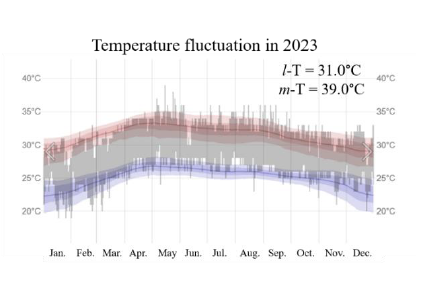Impact of Rising Air Temperatures on the Growth and Water Quality of Blue swimming Crab (Portunus pelagicus) Culture in Grow-Out Ponds:A Comparative Study of 2022 and 2023
Keywords:
Climate change, Blue swimming crab culture, Portunus pelagicus, Temperature fluctuations, Water qualityAbstract
This study examined the effects of increased air temperatures on the growth and water quality of blue swimming crabs (BSC), Portunus pelagicus, cultured in grow-out ponds in Prachuap Khiri Khan province, Thailand, over the years 2022 and 2023. Geographic data indicated that the average lowest temperature and maximum temperature in 2022 were 31.0°C and 36.0°C, respectively, while these values increased to 31.0°C and 39.0°C in 2023. Consequently, the average maximum temperature fluctuation increased from 33.5°C in 2022 to 35.0°C in 2023. Analysis of BSC culture across five batches per year (n = 5) revealed no significant differences in initial carapace width (CL) and body weight (BW) between 2022 and 2023. However, at 90 days of cultivation, BSC in 2023 showed a significantly (p<0.05) lower mean BW (52.66±1.45 g) compared to 2022 (61.55±5.50 g), while CL remained statistically similar between the years. Additionally, the mean specific growth rate was lower in 2023 (6.25±0.03%/day) compared to 2022 (6.48±0.10%/day) (p<0.05). These findings suggest that BSC growth in 2023 was adversely affected by higher temperatures, likely due to climate change. Increased temperatures also led to variations in average water quality parameters, with higher salinity (35.40±1.19 psu) and water temperature (32.19±1.83°C) observed in 2023 (34.09±1.75 psu, and 31.13±2.05°C in 2022) (p<0.05). However, parameters such as pH, dissolved oxygen, total ammonia, nitrite, and alkalinity did not exhibit consistent changes in response to increased temperature fluctuation. This study underscores the need for adaptive management strategies to mitigate the impacts of climate change on aquaculture systems.

